Mukarram Jah Bahadur @Nawab Mir Barkat Ali Khan
This is a collection of articles archived for the excellence of their content. |
Contents |
A timeline
1967: ‘recognition’ as ‘ruler of Hyderabad State’
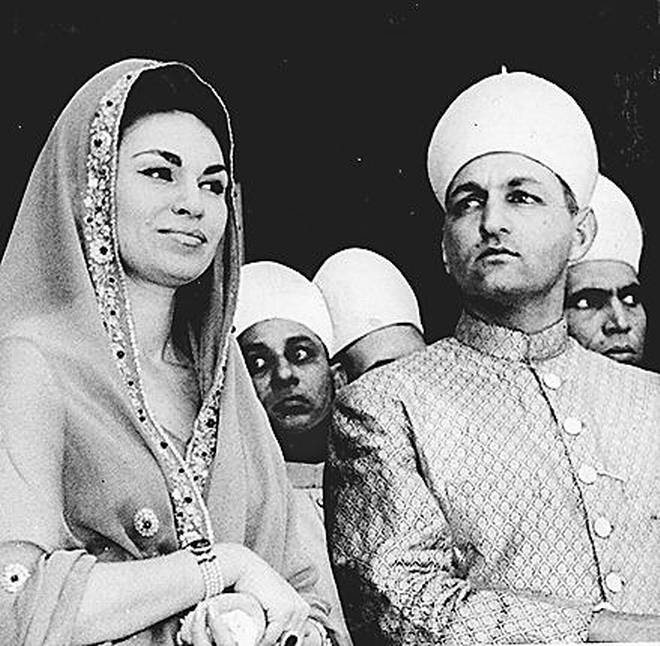
Photo Credit: The Hindu Archives
From: January 21, 2018: The Hindu
Information Commission pulls up Home Ministry over crucial file
Where are the 50-year-old records related to the government’s recognition of Nawab Mir Barkat Ali Khan as the ‘ruler of Hyderabad State’, the Central Information Commission has asked as it pulled up the Home Ministry, which said it was clueless about the crucial file.
Information Commissioner Yashovardhan Azad has also marked a copy of his order to the Union Home Secretary with the recommendation that a committee should be constituted to identify such files of historical importance and ensure that they were handed over to the National Archives.
“It would also be in order that the process of transfer of files to the Archives, which was initiated in 1981, is monitored in the correct fashion so that chronology is maintained in the transfer of files. This would be a real treasure house for the researchers and scholars as well as the public at large while browsing through the pages of history,” he noted in a recent order.
Fresh search ordered
He directed the Ministry to conduct a fresh search in the light of the document and if the file is traced, provide a copy of the certified information as sought by RTI applicant Sayed Khaliq.
The roots of the case go to the late Nizam of Hyderabad Mir Osman Ali Khan, the last ruler of the princely state who had nominated his grandson Nawab Mir Barkat Ali Khan, also known as Mukarram Jah Bahadur, as his successor making him the titular Nizam.
He had sought recognition of the government of India for it. A ‘certificate of recognition’ was issued by the Union government with effect from February 24, 1967 — the date on which the Nizam died.
Nawab Khan came into possession of all the moveable and immovable properties of the Nizam making him one of the richest men in India.
A brief profile
Neelam Raaj & Syed Akbar, August 2, 2020: The Times of India

From: Neelam Raaj & Syed Akbar, August 2, 2020: The Times of India

From: Neelam Raaj & Syed Akbar, August 2, 2020: The Times of India
Sex, politics, Partition: The enthralling tale of the ‘world’s richest man’
It all started in 1948 when one million pounds belonging to the seventh Nizam of Hyderabad were deposited in a London bank. With two nations, and over 120 heirs claiming the Nizam’s cash, it took 72 years and a long legal battle to resolve the case
It’s one of the most curious tales from the Partition era, and it has more masala than any Bollywood potboiler — sex, politics, royalty, rivalry, lots of money — and for India, a happy ending with a win over Pakistan.
Let’s start with the ending, which came this month after a high court in London dismissed claims by the extended family of the eighth Nizam of Hyderabad, Prince Mukarram Jah, on 35 million pounds (approx Rs 332 crore) sitting in a London bank since 1948, thus ending a 72-yearold legal battle which came to be called the Hyderabad Fund case.
A year earlier, the court had thrown out Pakistan’s claim over the money, and divided it between Prince Jah, his younger brother and India.
WORLD’S RICHEST MAN
Now for the man whose money this originally was — Mir Osman Ali Khan, the seventh Nizam of Hyderabad and once the richest man on the planet who featured on the cover of Time magazine. His sexual exploits were legendary. In a piece for The Guardian, William Dalrymple wrote that after he died, Mukarram Jah not only inherited debt but also “a ridiculously inflated army of retainers: 14,718 staff and dependants, including 42 of his grandfather’s concubines and their 100-plus offspring”. Osman Ali is said to have used a diamond as paperweight, owned a fleet of Rolls Royces including a Silver Ghost Throne car and, according to a book by Dominique LaPierre and Larry Collins, possessed a huge porn collection.
HOW NIZAM’S MONEY ENDED UP IN UK
Even after British rule ended, Osman Ali Khan refused to join the new Indian Union. A little dig into history shows that the British had given three options to the dithering Nizam before leaving India in August 1947 — join India, join Pakistan, or remain independent. The Nizam had sought time and entered into a standstill agreement with India. Meanwhile, the Police Action took place, leading to the merger of the princely state with the Indian Union on September 17, 1948.
However, just before the annexation, the Nizam’s finance minister Moin Nawaz Jung transferred one million pounds to the account of Habib Ibrahim Rahimtoola, then high commissioner of Pakistan in London. One of the theories was that the princely Hyderabad state wanted Pakistan’s help to secretly purchase one lakh .303 rifles to withstand the might of the marching Indian Army. However, the money wasn’t transferred as the Nizam, probably under pressure from India, cabled the bank to freeze the transaction saying the money was deposited without his sanction.
LEGAL BATTLE STARTS IN 1954
The Nizam filed a lawsuit in 1954 against Pakistan and NatWest Bank, where the one million pounds — which has since multiplied to 35 million pounds — was deposited. The Indian government, which joined the fight later in 1965, said the Hyderabad Fund was rightfully theirs as the Nizam assigned his claim to the Hyderabad Fund to the President of India.
However, Pakistan invoked sovereign immunity which meant the case couldn’t proceed, and remained frozen till 2013.
Meanwhile, India-Pakistan relations deteriorated and despite occasional thaws, efforts to reach an out-of-court settlement came to naught.
PAK TWIST IN 2013
In a newspaper column, T C A Raghavan, former Indian high commissioner in Pakistan, writes that in 2013 Pakistan made an about-turn from its ‘sovereign immunity’ stand by filing a case against the bank claiming the funds for itself. Its argument was that it had been given the money to buy weapons for the Nizam and had done so. In fact, it stated that Australian mercenary pilot Sydney Cotton had even made a few sorties over Hyderabad to drop arms in 1948. The Nizam, it said, had only reversed his stand following pressure from India after the accession.
But the change in Pakistan’s stand meant the ownership of the money could be decided in a court of law. India and the Nizam’s heirs accordingly became a party to this case by claiming ownership for themselves jointly.
PAKISTAN LOSES CLAIM
The case was finally decided in favour of India and the Nizam’s legal heirs — Mukarram Jan and his younger brother Muffakham — on October 2, 2019, though the details of how the 35 million pounds will be divided between the two parties have been kept secret. The administrator to the Nizam’s estate got just 400,000 pounds which has to be divided among 120 descendants. “The court made it clear that it did not think the money was handed to Pakistan outright. There is overwhelming evidence that Pakistan only held the money as a trustee and it actually belonged to the Nizam,” Paul Hewitt, the lawyer for Jah, told the BBC after the verdict.
THE LONELY PRINCE
For a man who was heir to one of the largest fortunes in the world, Mukarram Jah’s life hasn’t been easy. His troubles started when his grandfather died in 1967. “Everything was in disarray: the Nizam’s garages, for example, cost £45,000 a year to keep in petrol and spare parts for 60 cars, yet only four were in working condition, and the limousine supposed to carry the new Nizam from his coronation broke down. Most debilitating was the legal wrangling initiated by the several thousand descendants of the different Nizams, almost all of whom claimed part of Jah’s inheritance,” wrote Dalrymple. Even Mukarram’s father — disinherited for being a “moral pervert” — wanted a share. The fed-up prince first fled to Australia, leaving his estate to managers who plundered and sold whatever they could. His second wife, an Australian, entered into a bisexual relationship, divorced him and later died of AIDS. None of his five marriages worked out, and he now lives alone in a modest two-bedroom apartment in Turkey, says John Zubrzycki, the author of The Last Nizam: The Rise and Fall of India’s Greatest Princely State and one of the few journalists to have met him there. Zubrzycki told TOI that he would stop short of calling him a failure. “He failed to come to grips with the responsibilities of managing his estate and Hyderabad’s heritage, but he was also surrounded by people who gave him poor advice, who took advantage of his lack of experience and who were frankly just wanting to get whatever they could out of him. He constantly stressed that he was trained to be a soldier, not to take over the remnants of his father’s kingdom.”
Now 86 years old, Jah says he is tired of legal battles. Though the case relating to the 35 million pounds is settled, the other descendants have now filed a fresh case over the 400,000-poundsettlement the court-appointed administrator managed to get for the Nizam’s estate in the secret deal with the GOI and the two grandsons of the Nizam. However, Jah has relinquished his share of this money to the other 120 or so descendants.
Love Sex and Dhokha
Osman Ali was officially called His Exalted Highness, but was nicknamed His Exhausted Highness because of his extensive love life
He had a fleet of 60 luxury vehicles including a Rolls Royce Silver Ghost
Some say he had the largest private porn collection in the world
His son Mukarram Jah married five times, first to Princess Esra from Turkey
Jah’s second wife was an Aussie girl call Helen, who got AIDS after an affair with a bisexual man and died. The third wife was a former Miss Turkey.
2023
Syed Akbar, January 15, 2023: The Times of India
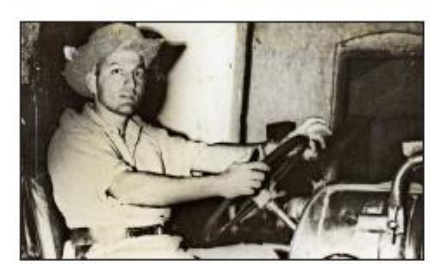
From: Syed Akbar, January 15, 2023: The Times of India
Hyderabad : Mukarram Jah was the titular Nizam VIII of Hyderabad who left India almost halfa-century ago.
Mukarram — whose maternal grandfather was erstwhile Ottoman empire ruler Caliph Abdul Mejid II—will be laid to rest at the ancestral graves , near Charminar, in accordance with hiswishes to be interred in his homeland, the family said.
Mukarram, who had married five times and last visited Hyderabad more than a decade ago, was educated at Doon, Harrow, Cambridge and the London School of Economics. He was also trained at the Royal Military Academy Sandhurst in England.
Born to Prince Azam Jah and Princesses Durru Shevar as Mir Barket Ali Khan on October 6, 1933 in Nice, France, Mukarram was named the successor of the Asaf Jahi dynasty by his paternal grandfather and Nizam VIIMir Osman Ali Khan.
The Nizam had bypassed his sons to anoint Mukarram as his successor. Mukarram would have also become the spiritual leader (Caliph) of Muslims had the Caliphate in Turkiye been revived. After the death of the Nizam VII, Mukarram was recognised as the Nizam VIII of Hyderabad and Berar by the Centre in 1969. He was officially coronated as Nizam VIII on February 24, 1967, and held the title till November 1971 when the Centre abolished the privy-purse — a grant given to erstwhile royalscions.
Assets in London
Indian govt, 2 grandsons to get £35m: UK HC
Naomi Canton, Nizam’s £35m to go only to Indian govt, 2 grandsons, July 23, 2020: The Times of India
London:
The Nizam’s money, held in a London bank for about seven decades, will go to Nizam VII Mir Osman Ali Khan’s grandsons Mukarram Jah and Muffakham Jah and the government of India (GoI). The London high court junked the claims of other descendants of the last ruler of the princely Hyderabad state.
Najaf Ali Khan, grandson of the last Nizam and about 120 others, claimed they had been deprived of their share of the £35 million (Rs 332 crore) which was split in a confidential pact between the GoI and the Nizam’s two grandsons. But the court prevented Najaf and others from getting their hands on the money. The London court last year had decreed that the money belongs to the GoI and the two grandsons while junking Pakistan’s claims.
Vignettes
Syed Akbar, January 17, 2023 The Times of India
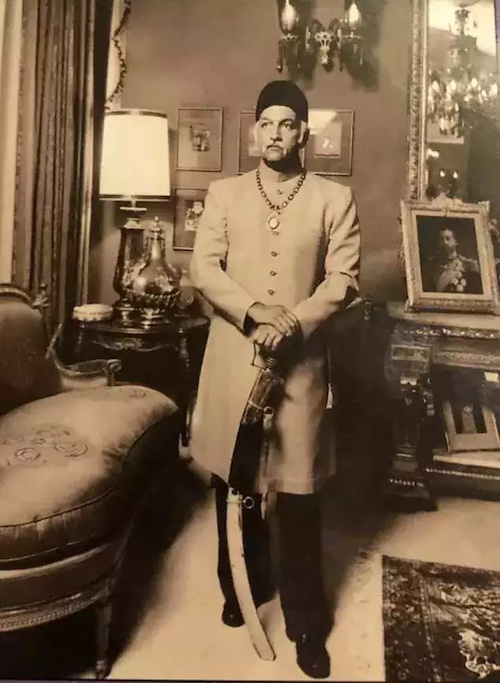
From: Syed Akbar, January 17, 2023 The Times of India
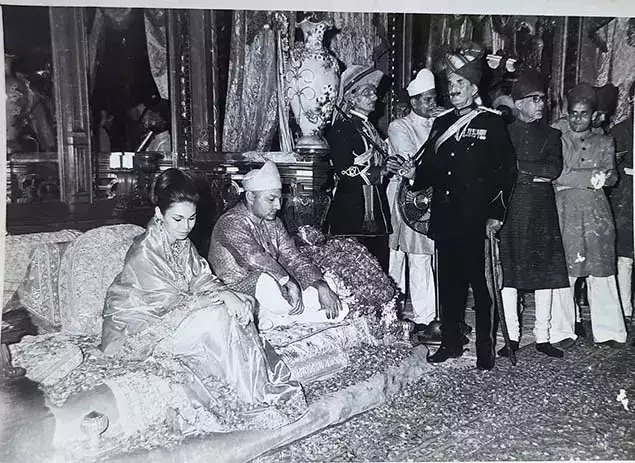
From: Syed Akbar, January 17, 2023 The Times of India
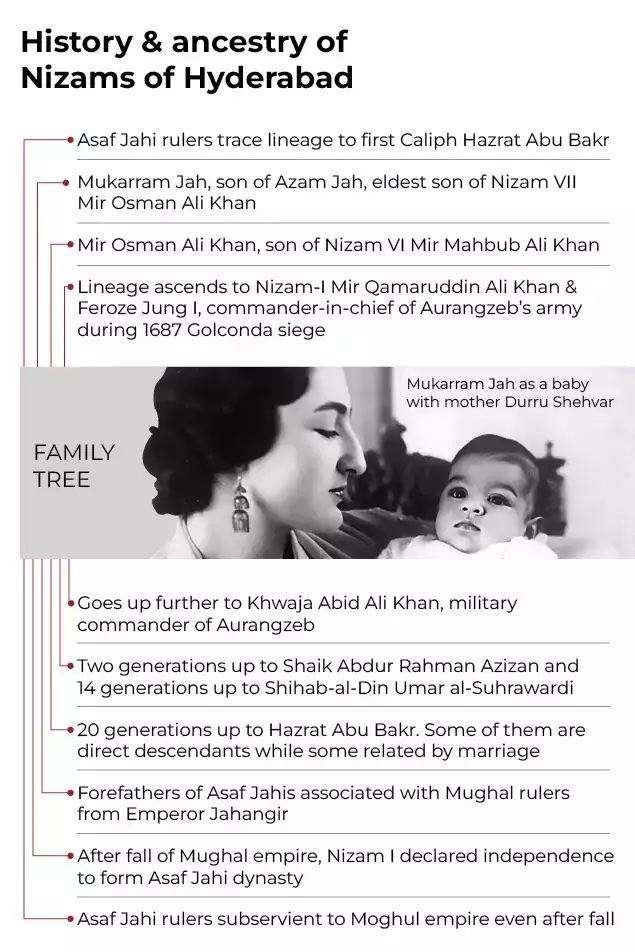
From: Syed Akbar, January 17, 2023 The Times of India
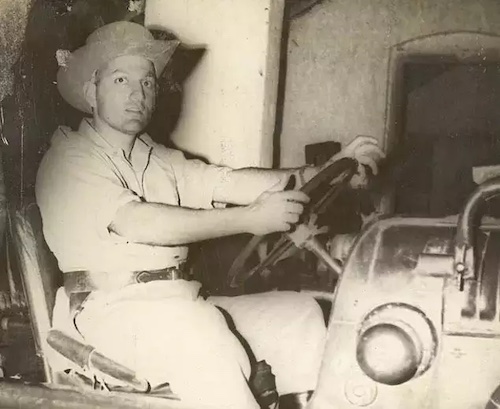
From: Syed Akbar, January 17, 2023 The Times of India

From: Syed Akbar, January 17, 2023 The Times of India
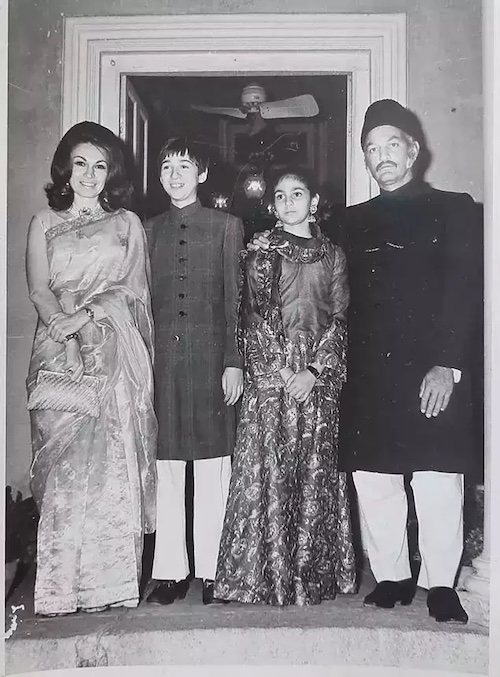
From: Syed Akbar, January 17, 2023 The Times of India

From: Syed Akbar, January 17, 2023 The Times of India
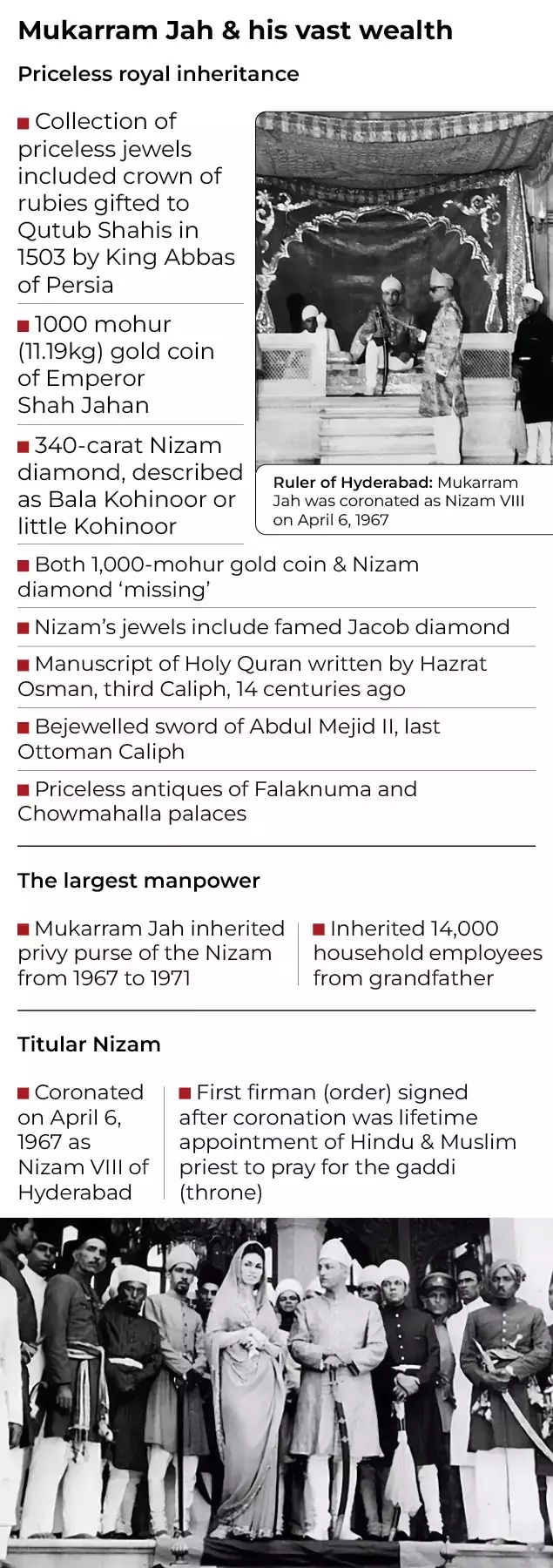
From: Syed Akbar, January 17, 2023 The Times of India

From: Syed Akbar, January 17, 2023 The Times of India
It was once the richest family not just in the county, but in the world – a family with enthralling tales of the Partition era, that included sex, money, royalty, politics, Pakistan, and lots of money.
On January 14, Mukarram Jah, the titular Nizam VIII of Hyderabad, passed away at his residence in Istanbul, Turkey, where had been living for the past several years. Jah last visited Hyderabad more than a decade ago.
Informal curtains for Asaf Jahi dynasty
With his death the Asaf Jahi dynasty informally comes to an end – informally, because the Asaf Jahi regime officially ended with the merger of Hyderabad State with the Indian Union on January 25, 1950.
Born to Prince Azam Jah and Princess Durru Shehvar as Mir Barkat Ali Khan on October 6, 1933 in Nice, France, Jah was made successor of the Asaf Jahi dynasty by his grandfather, Mir Osman Ali Khan, the seventh Nizam of Hyderabad, who bypassed his eldest son and crown prince Azam Jah.
Mir Osman Ali Khan ceased to be the ruler of princely Hyderabad on January 25, 1950 after he accepted the Indian Constitution. The next day – January 26, 1950 – he assumed charge as Raj Pramukh or governor of Hyderabad. In June 1954, the Nizam VII requested the central government to recognise Jah as his successor. A decade later (1964), Jah was recognised as successor of the Asaf Jahi dynasty.
Following the death of his grandfather on February 24, 1967, Jah was recognised as the "ruler of Hyderabad" (Nizam VIII of Hyderabad and Berar) by the central government. He was officially coronated as the Nizam VIII of Hyderabad on April 6, 1967. He held the title till November 1971 when the central government abolished the privy purse and royal titles. This meant there would be no official successor to Mukarram Jah, and thus no Nizam IX.
But even though he lost the official title in 1971, many people still refer to Jah as the last Nizam of Hyderabad. His mother Durru Shehvar was the daughter of Caliph Abdul Mejid II of Turkey, the last ruler of the Ottoman empire. The marriage brought the Nizam of Hyderabad and the deposed Caliph together.
Vast fortune…but many troubles
Jah studied at the best schools – Doon, Harrow, Cambridge and London School of Economics. He also trained at the Military Academy of Sandhurst in England.
The grandson of Nizam VII, once the richest man of his times, he went on to inherit a vast fortune, but could not hold it for long. In a piece for The Guardian , author William Darylmple wrote that after the seventh Nizam died, Jah inherited a “ridiculously inflated army of retainers, 14,718 staff and dependents, including 42 of his grandfather’s concubines and their 100-plus offspring”.
At one stage he was even declared asset rich but cash poor. He inherited several properties in Hyderabad – the famed Falaknuma Palace, a dream in mortar and stone, the magnificent Chowmahalla Palace, the flamboyant Chiran Palace, and the crumbling King Kothi palace in Hyderabad, besides the Purani Haveli.
Other inherited items included priceless jewellery, a 12-kg gold coin last seen in 1987 and the Nizam diamond.
“For years I had read stories of the eccentric ruler of a Muslim state who counted his diamonds by the kilogram, his pearls by the acre, and his gold bars by the tonne, yet who was so frugal he would save on laundry bill by bathing in his clothes," wrote John Zubrzycki, the author of The Last Nizam : The Rise and Fall of India's Greatest Princely State , while describing Jah.
But the vast fortune soon became difficult for him to manage.
“Everything was in disarray: the Nizam's garages, for example, cost £45,000 a year to keep in petrol and spare parts for 60 cars, yet only four were in working condition, and the limousine supposed to carry the new Nizam from his coronation broke down. Most debilitating was the legal wrangling initiated by the several thousand descendants of the different Nizams, almost all of whom claimed part of Jah's inheritance,” wrote Dalrymple. Even Mukarram’s father – disinherited for being a 'moral pervert' – wanted a share.
In 1972, the fed-up Nizam left India to settle down in Australia where he purchased 5,00,000 acres of sheep farm but suffered heavy losses there. He later moved to Austria and finally Turkey.
Back in India, he left his estate to managers who plundered and sold whatever they could.
Married five times, Jah lost a large part of his wealth in divorce settlements. He first married Princess Esra of Turkey in 1959. In an interview published in Youandi.com, Princess Esra talks about her early married life in Hyderabad.
"I always wanted to do something for the city, but it was a bit difficult when I got married because my husband's grandfather was alive, and my life was very restricted back then. There was a certain way one had to behave, places one could go, and who one could see. After his death, however, we had the possibility to do things our way, but then we had enormous problems: the death duty, the tax was 98 per cent, etc.”
"Then our privileges were taken, and the land was taken; it was impossible to keep up one's dreams," Princess Esra is quoted as saying. Later on, at Jah's request, she returned to Hyderabad to bring some order to the Nizam's estate.
Jah’s second wife, an Australian, entered into a bisexual relationship, divorced him and later died of AIDS. None of his five marriages worked out, and he eventually lived alone in a modest two-bedroom apartment in Turkey, says Zubrzycki, one of the few journalists to have met him there. Zubrzycki says he would stop short of calling Jah a failure. “He failed to come to grips with the responsibilities of managing his estate and Hyderabad's heritage, but he was also surrounded by people who gave him poor advice, who took advantage of his lack of experience and who were frankly just wanting to get whatever they could out of him. He constantly stressed that he was trained to be a soldier not to take over the remnants of the kingdom.”
But there was some solace for Jah in the way of a ruling by a London court in his favour (and his brother and Government of India) of the long-pending Hyderabad Fund case.
The case related to the transfer of one million pounds to the account of the high commissioner of Pakistan in the UK before the Police Action in 1948. The money grew to £35mn when the case was settled by the London court in 2020. The amount was shared among Jah, his brother Muffakham Jah and the Government of India in a secretly-kept ratio.
Caliph dream eluded the Ottoman-Asaf Jahi scion
Jah preferred a secluded life away from the glamour. But the scion of the Ottoman-Asaf Jahi kingdoms could well have been the 'spiritual' guide of the 1.7bn Muslims the world over.
His maternal grandfather, Caliph Sultan Abdul Mejid II, had already lost his Ottoman empire and Caliphate when Jah was born in 1933. The Caliphate was abolished in March 1924. But, Abdul Mejid II, had willed that in case of revival of the Caliphate in the future, Jah would be his successor. The matrimonial alliance between the Asaf Jahis and the Ottomans was not without a reason. While the Ottoman rulers were the spiritual head of Muslims, the Asaf Jahis trace their ancestral lineage to Hazrat Abu Bakr, the first of the righteous Caliphs of Islam. When Jah’s paternal grandfather Mir Osman Ali Khan, offered his son Prince Azam Jah in marriage to Princess Durru Shehvar, daughter of Abdul Mejid II, he was reviving the bonds of the Asaf Jahi family with the Caliphate.
But for the abolition of the Ottoman Caliphate in 1924, the Asaf Jahs would have inherited the Islamic mantle as Abdul Mejid II had no male issue. His only successor was grandson Mukarram Jah.
On January 18, as Jah's body is laid to rest at the ancestral graveyard of the Asaf Jahis in the historic Mecca Masjid near Hyderabad's Charminar, many unanswered questions about his life, inherited riches and his life away from India will perhaps be buried forever.
See also
Mukarram Jah Bahadur @Nawab Mir Barkat Ali Khan